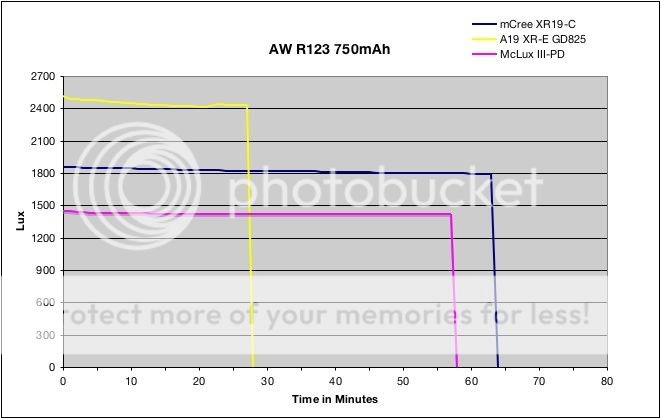______________________________
FAQ: McLuxIII Ti Series
______________________________
Note:
All those interested in the newest iteration of the McLuxIII-Ti-Series, the LunaSol lights, should go here:
https://www.candlepowerforums.com/posts/2407045#post2407045
This is the FAQ for the McLuxIII Titanium Series of lights by McGizmo.
As those lights originate from the McLuxIII-PD and develop that concept further, please refer to the McLuxIII-PD FAQ for the basics while this FAQ will expand on the new characteristics specific to the new titanium lights.
Because of the rapidly changing landscape of LED those lights were initially called "mCree" lights for their use of the Cree XR-E LED, but that concept had to be abandoned due to new LEDs arriving. They are now integrated in the new McGizmo nomenclature with the current name.
In this FAQ only the new XR19 and XR27 / S27 lights with either C-Pack or PD-Pack are discussed as the other titanium lights (McLuxIII-Ti-PD and McLuxIII-T) are already covered in the McLuxIII-PD FAQ.
What are the McLuxIII-Ti lights?
The lights are those:
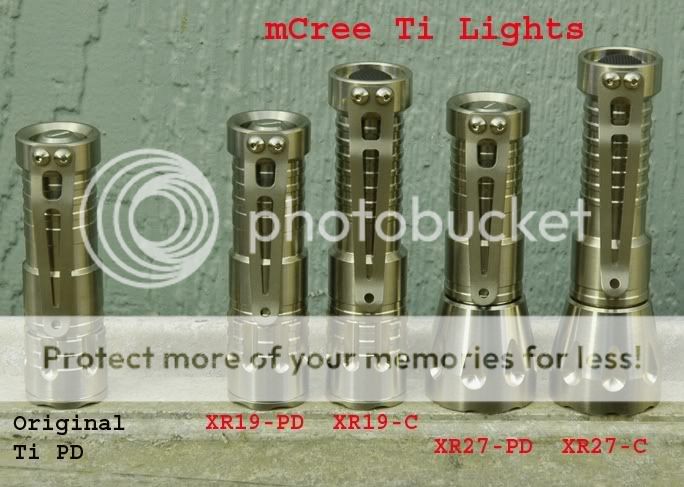
There are two types of heads ... the XR19 and the XR27 ... and two types of bodies ... the C-pack and the PD-pack. Combinations of those form the different lights pictured above. The referenced light on the left hand side is the McLuxIII-ti-PD, the titanium version of the McLuxIII-PD.
Here is a size comparison between the XR19-C, the McLuxIII-ti-PD and the McLuxIII-T:
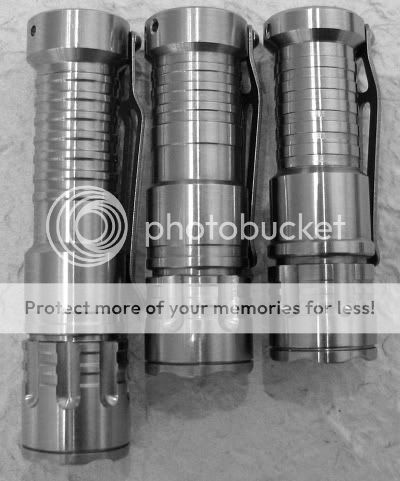
What about Lego then?
Heads and bodies of the new lights are interchangeable. You thus need to buy two lights to have all parts at hand to be able to build all iterations by simply swapping heads / bodies.
The McLuxIII-ti-PD is compatible, too, but the McLuxIII-T is not, only the head of the "T" will work on both new packs.
This is an example of the XR19 head on the body of the McLuxIII-ti-PD forming a XR19-PD:
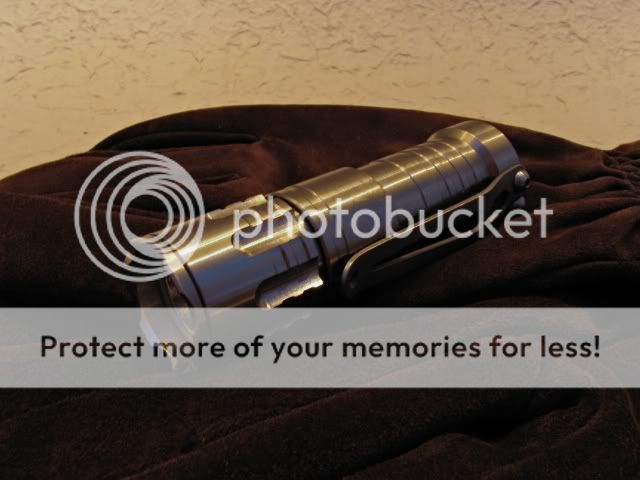
Construction
The McLuxIII-Ti lights are made of titanium in and out except the heatsink inside the head which is aluminium. The window is a 2mm optically coated (inside) Sapphire Crystal. The clip is bead blasted titanium held in place with titanium screws. As the C-pack is longer it sports a new and longer clip with a similar form factor, function and quality.
At the business end of the XR19 head there's now not a simple o-ring but a glow-ring:
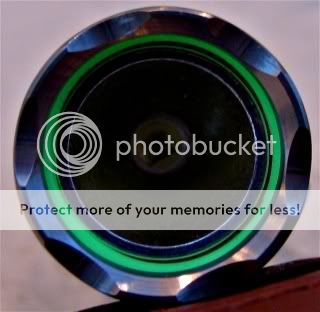
Both lights use well-known reflectors from the McR-XX Line that have been adapted to use the Cree LED. It is the McR-19XR and the McR-27XR, thus the name of the lights and heads. Due to the additional height necessary to properly focus this LED the heads are longer than the standard McLuxIII-PD head.
The reflector in the XR19 head has an O-ring around it which helps centering it as well as retaining it in position in the head.
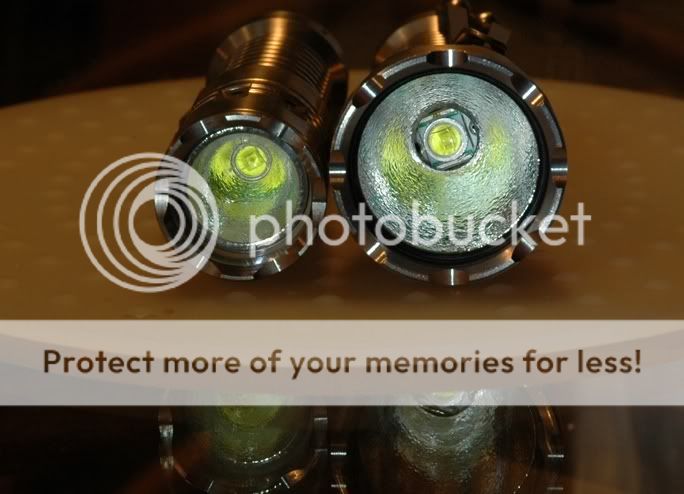
These lights will all be host to a Cree XR-E LED mounted on a MCPCB. The bin of the LED is P4 or better.
While the XR19 head has a traditional front end with the well-known titanium bezel ring, the XR27 head uses a system with two o-rings to hold the window in place similar to the HD45 lights. You will notice that the XR19 head now has 8 grooves for better grip as opposed to the 6 grooves of the McLuxIII-ti-PD.
The converters and heat sinks are held in place by a screw in a similar but not identical way as with the McLuxIII-ti-PD. For further details about the building process of those please refer to this thread:
http://candlepowerforums.com/vb/showthread.php?t=142830
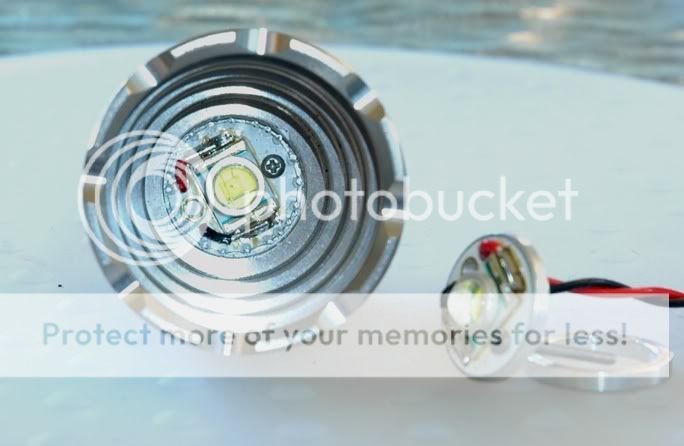
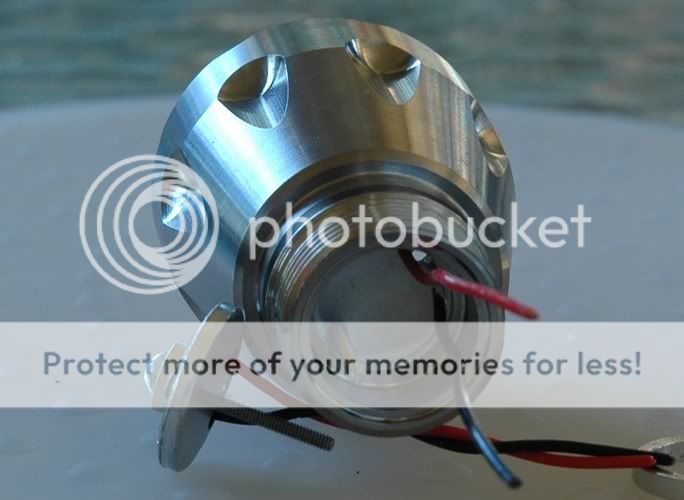
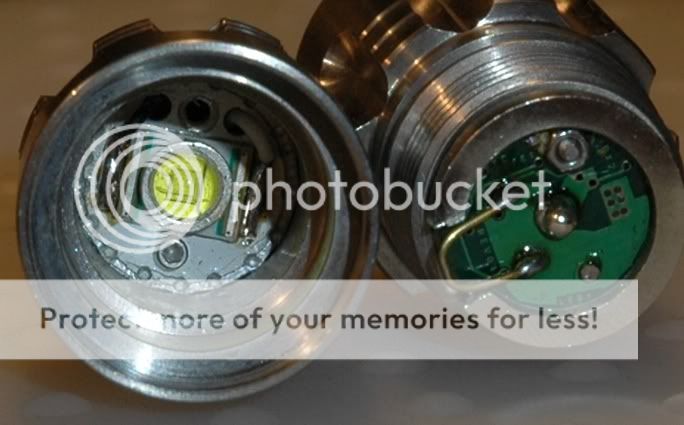
The PD-pack will be very similar to the kown PD bodies and will most likely sport a H3-vial in the tail end of the piston.
The C-pack however, incorporates a new rear-end seal. It is also thinner than the PD-pack because of the missing piston.
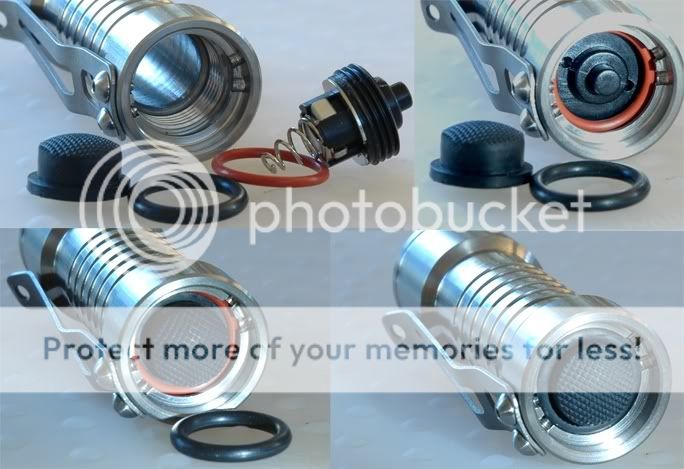
It uses a user-accessible and -replaceable McClicky switch module for single stage clicky-action with momentary on. No reverse clicky.
The switch boot is held in place with two o-rings and is not screwed in with a metal ring. The reasons for this are:
- this method serves as a pressure relief in case of a battery problem
- it is easily user accessible and easy to clean
- it is watertight, at least in the testing done so far in the ocean*)
For further details refer to the above-linked thread.
These parts are all in contact and some compression with eachother with the result that it takes some additional force to push the button in for momentary and an obvious additional effort to push the button in far enough to latch the light on. The force is not excessive by any means but it is not a simple feather touch either.
You can stick your finger into the side of the button, inside of the guard and pop up the boot and retaining O-ring for removal. It is highly unlikely that an encounter would accidentally pop the boot out ... but still a remote possibility. If one is concerned about this, one could use some type of rubber sealant or glue to bond the components in place and understanding that they would have to overcome those bonds should they want to disassemble the pak.
One thing that might or might not occur (depending on the individual light and parts) is that the rubber boot of the C-pack could extend past the rim of the pack and cause the light to wobble when in tailstand, especially when the light is hot from long burns and the internal pressure builds up. See this thread for more details:
https://www.candlepowerforums.com/posts/1756134#post1756134
*) McGizmo's testing facilities have the following to report: "I water tested the first article a number of times (successful) and today, in the spirit of R&D after reading your question, I took one of the production heads and clickie paks to the beach for a swim. I took it down to about 25' and clickied ita few times on the way down as well as up. Repeated a couple times. There was no water entry. I left all the guts out so I could peer into the window to see where the water might enter if it did. The design is sound but depends on clean and proper seals. The retaining O-ring is snug against the OD of the boot so I think the seal will be good at warding off dirt and grime that likes to work its way into many seal systems. I am very comfortable claiming the clickie and heads to be water resistant provided seals are as they should be. The design is such that increased pressure will increase the pressure of the seal and not encourage a breach."
More extensive and advanced research was done by Mr_TED_BEAR who "subjected the light to 90psi. Translated that is approximately 6 atmospheres or 180 feet depth equivalent. No leaks."
The Seoul P4 LED in the XR27 head
With the appearance of the Seoul P4 LED that uses the same die as the Cree XR-E (the EZ1000), the XR27 head was changed and now uses the Seoul P4 LED instead of the Cree. Only a few of the XR27 heads with the Cree got made, and this head is now called the S27 Head.
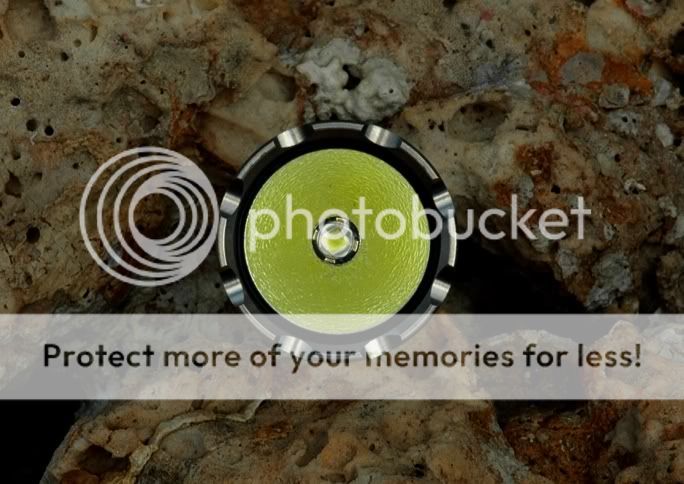
This Seoul P4 LED offers the same brightness and efficiency as the Cree but has a lambertian radiation pattern resulting in a beam that is very similar to the Luxeon beams in the reflectors we know. This means that the S27 head will have a beam pattern similar to lights using the McR-27L, for example the McLuxIII-27LT.
Currently SSC P4 U-bin LEDs will be used. Don measured 94 lumens luminous flux with a such an U-bin equipped S27 head in his IS at 525mA. This might not be an 100% exact number, but it gives us an idea about the flux to expect.
Which Titanium Alloy is used?
To date, the Ti parts provided have all been 6-4. With these new mCree Ti lights, the first run of XR19 heads as well as C paks are all 6-4. The bezel rings on the XR-19 heads are 6-4. The XR27 heads are CP (grade 2). It is likely that the PD paks, pistons and sleeves will be CP at least initially. Beyond this and into the future, Don has asked the machine shop to use either material at their discression and based on price and availability at the time. For all intents and purposes the advantages and disadvantages of the two alloys don't amount to any significance in these lights. 6-4 has an advantage in terms of yield and tensile strength whereas CP has an advantage (by the numbers) in terms of both a lower electrical resistance and lower thermal resistance. Without some sophisticated equipment or sending out for a lab test, none of us would be able to determine which alloy we had in hand.
Titanium is ultra-heavy, right?
Ti-PD (original luxeon version) - 98 grams
Ti XR19-PD -105 grams
Ti XR19-C - 106 grams
Ti XR27-PD - 128 grams
Ti XR27-C - 129 grams
All measurements with SF CR123 on board.
Ergonomics and Using the Light
The lights have two access points to the user interface: rotating the head and doing something at the rear end, depending on the pack you have.
Twisting the head will give you (from OFF position) constant low and upon further rotation constant high mode.
The PD-pack is for momentary activation only. By pressing the piston it gives you from OFF position first momentary low and then momentary high when depressing it deeper. You can of course also have momentary high when in constant low mode via the head which is perhaps the most important feature of this combo.
The C-pack functions just like a normal clicky à la SF Z57 et al.. This means you can pre-dial you desired light level at the head and then use it momentarily or constantly with the clicky. But you do not have momentary high from constant low.
Apart form the obvious differences in the user interface of the two packs ... the C-pack is also longer due to the clicky module and thinner due to the missing piston.
In the end it all comes down to personal preferences and tastes. Chose the interface you would like to use.
Those lights are KISS (keep it super simple) lights that offer 2 regulated levels of light, just like the predecessors of the McLuxIII Series. No complicated modes and menues. No SOS function
Titanium Threads and Twisty Action
This is an issue. The threads are considerably rougher than anodised aluminium threads, and they will require breaking them in. Unfortunately this cannot be done at the huge McGizmo manufacturing plant, so it will be up to the end user.
The threads will get softer, but usually not to the point that they feel like an aluminium PD, for example.
As a consequence, those lights will almost certainly be two-hand twisters, at least untill broken in. Usually you can do it one-handed then, but YMMV.
LED and Electronics
The McLuxIII-Ti lights use the Cree XR-E LED in the XR19 head and the Seoul P4 LED in the S27 head. There is no guarantee on tint, and you should know that while the tint is usually pretty decent and quite uniform it still cannot match the tint perfection found in current Luxeon lights.
In the McLuxIII-Ti Series you get 2 levels of current regulated output.
The GDx2 converter is used in those lights - the same one used on the Ti PD's. Those are designed and built by Wayne (dat2zip, owner of the Sandwich Shoppe). Currently, the low mode is about 25 mA. This has been a reasonable low with the Luxeons and the McR-20, at least that seems to be the majority consensus. With the higher flux of the XR-E and SSC P4 coupled with the XR19 and S27 reflectors, the beam and spill intensities at 25 mA will be noticibly higher than the Luxeon based lights. This will please many and others will wish for an even lower drive level on low. High mode is 525mA as usual.
You can use primary CR123 cells as well as R123 Li-Ion cells in those lights as the GDx2 is a buck/boost converter.
Light output and Beam Shape
First ... the beams from the Cree based lights do not have any hole in very close work. The spot gets brighter and tighter as you bring the distance to target to zero.
Here's a beam study of the XR19 head:

And here are some comparison shots against some other well-known lights, mCree XR19 light always on the right:
vs Ti-PD with UV1J:

vs SF L5:

vs Aleph1 T-bin LuxIII at 1000mA:

(you can see the spill of the Aleph1 when you look carefully)
vs Fenix P1:

(spill of the Fenix is difficult to see)
vs SF A2:

(spill of the A2 is too large and dim to be more of a yellow hue in the pic)
Here's an outdoor shot of a McLuxIII-PD (UYAJ) vs the XR19:
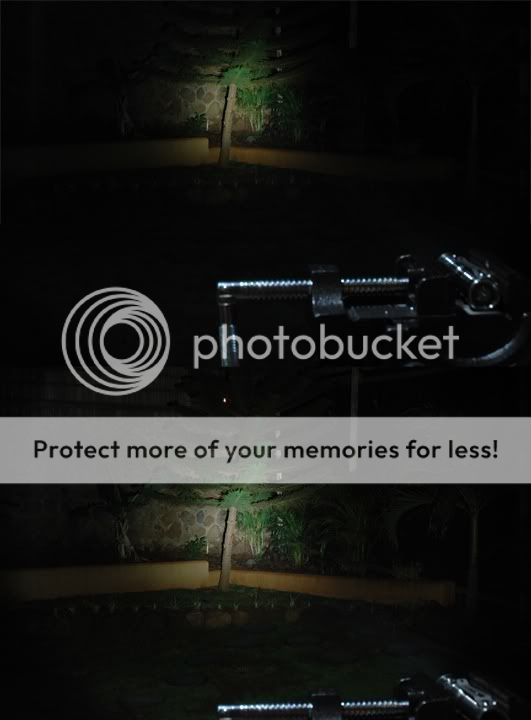
The beam from the XR19 is a generous hotspot and generous corona and a very tight and very bright spill. Due to this fact the low mode makes use of the complete beam admiringly well (as opposed to the Aleph1 for example where the low mode is usually just the spot) ... AND the high beam offers an awesome field of vision with the best "throwing" corona in this size class, making this light tremendously useful in everything but long distances.
However ... the XR19 is not a flood light ... it won't light up everything around you without having to move the light around as the beam is too concentrated for that.
Total luminous flux depends on the bin of the LED used and is considerably higher than current Luxeon lights at the same drive level.
The S27 head has (roughly) the same luminous flux as the XR19, but a different beam pattern offering more throw. This beam is virtually identical with the LuxeonIII in a McR-27L like in the 27LT, for example. The rare XR27 heads do sport a different beam pattern, see below.
Here are some beamshots for beam comparisons, but those are not shots of the actual lights, sorry.
McLuxIII-27LT (LuxIII UX1K at 917mA) vs. Cree version of that light with McR-27XR:
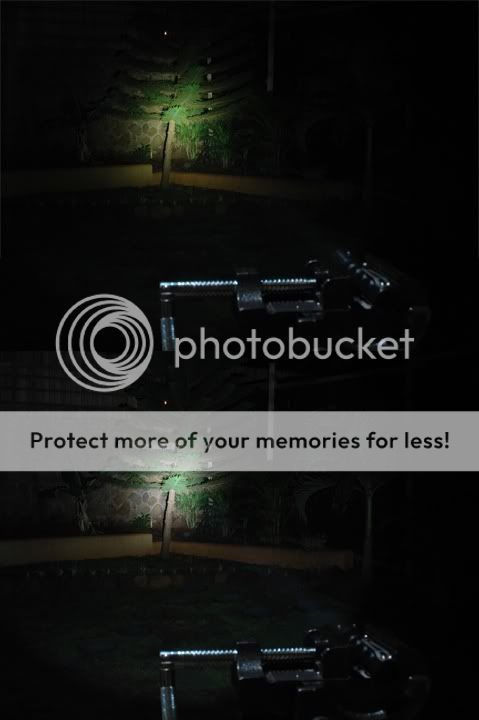
27XR modded McLuxIII-27LT (same light as above) vs. mCree XR19 light:
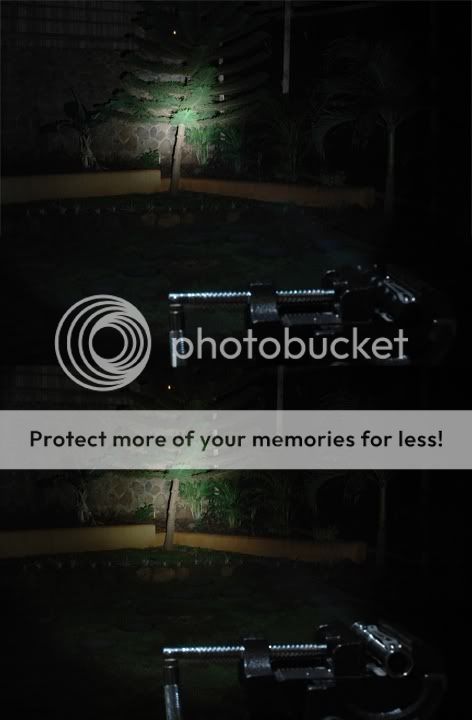
Here's a white wall study of a S27 head vs a XR19 head done by PSM with different exposures:


And the same two lights outdoors:
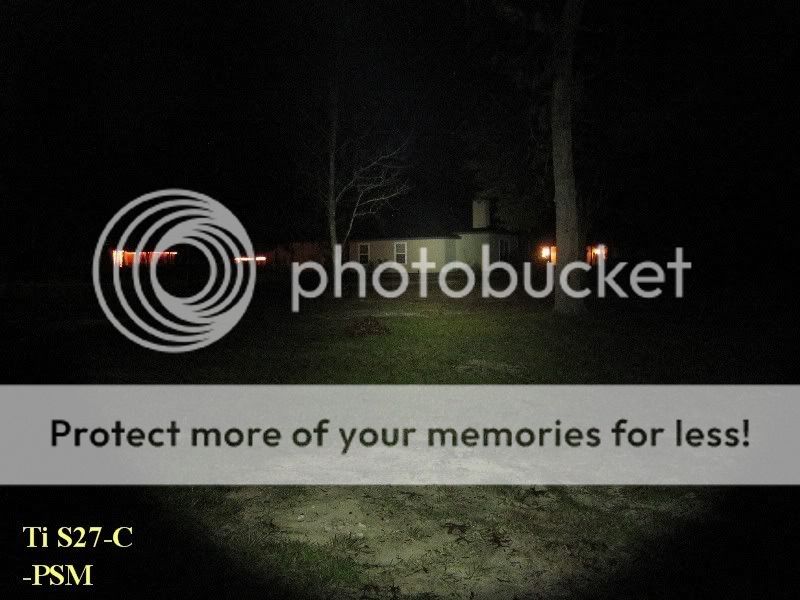
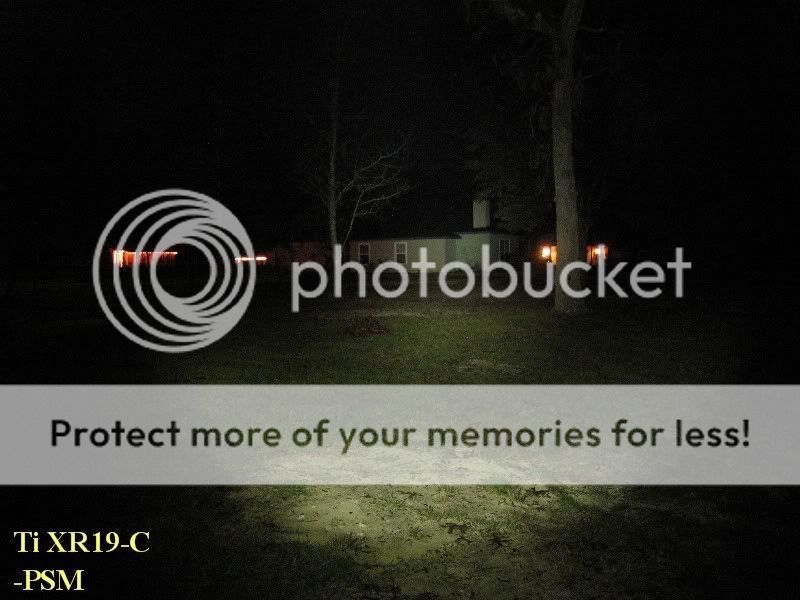
And here's an animated gif done by the same man and animated by jch79 of some xCree lights and the Aleph19 from the Shoppe in a ranged shootout:
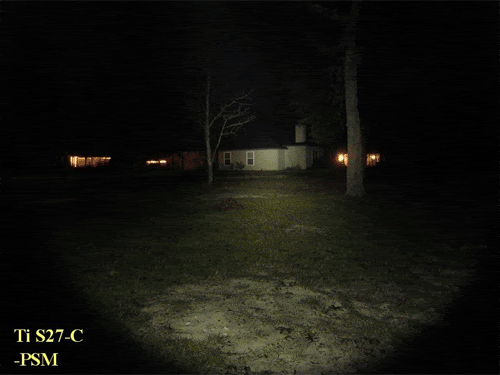
Runtimes
No "official" runtime tables yet, but as the Vin of the Cree is quite similar to current LuxIII offerings, the runtimes obtained with these lights *should* at least match those of the classic McLuxIII-PD.
Meanwhile ... here's a graph done by jch79 with various batteries and lights:
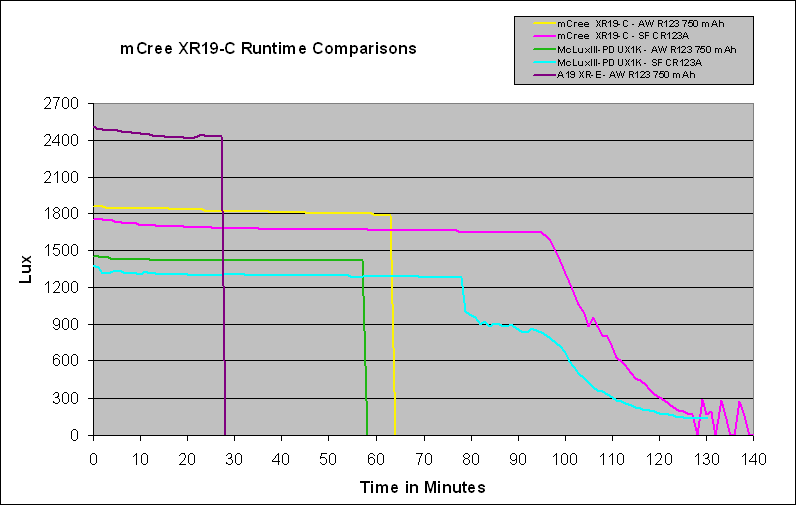
O-ring Sizes
XR-19 Head:
Window seal - #019 EPDM (or the GID silicone)
Head to pak seal - #017 Silicone (red)
C pak:
Boot Seal O-ring - #016 Silicone (red)
Boot & Seal Retaining O-ring - #113 EPDM
XR27 & S27 Head:
Window Seal O-ring - 2 x 22 mm Buna (Nitrile)
Window retaining O-ring - #025 EPDM
Head to pak Seal - #017 Silicone (red)
27LT & 27LT-S head:
Window Seal - #023 EPDM
2x head to Pak seal - #017 Silicone
PD Piston:
Piston to sleeve seal - #015 Silicone (use #016 for added protection but stiffer activation)
PD head:
Window Seal O-ring - #019 EPDM
Head to sleeve seal O-ring - #017 Silicone
Mule head:
Window seal O-ring - #017
Window retaining O-ring - #018
2-cell Iterations of the Ti-Series Lights
The first 2-cell version coming out is the McLuxIII-S27-Cx2, which means an S27 head (Seoul P4 LED with McR-27S) on a 2xCR123 body with a rear clicky.
The light looks like this:
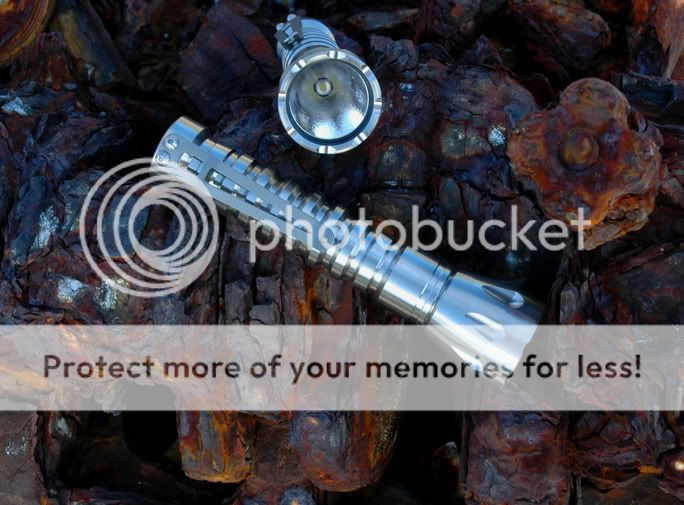
It sports a Seoul P4 of bin UW0I driven by a DBx2 driver with 917mA on high and 125mA on low level. The mechanical properties and the interfave are the same as with the other lights.
Please note that the titanium host might not be ideal for long burntimes on high, especially when left unattended.
This light will work on 1 x Li-Ion, and depending on the Vin of the LED it might run in regulation. If you have a Li-Ion cell that fits in the body, that is. Please use some caution when switching heads from 1x123 to 2x123 bodies !!!
when switching heads from 1x123 to 2x123 bodies !!!
Another : 2 x R123 might be a problematic combo with the DBx2 driver for unknown reasons. See this thread:
: 2 x R123 might be a problematic combo with the DBx2 driver for unknown reasons. See this thread:
https://www.candlepowerforums.com/posts/1964532#post1964532
The Mule
The Mule, or Mule head, is an alternate head for the McLuxIII Series that comes in titanium. It is this one ... mounted on a PD-Pack as sold in the first wave:

The Mule head houses a Cree XR-E LED without secondary optical element (--> without a reflector or optic) behind the usual 2mm thick sapphire window. It is powered by a GDx2 driver with the usual drive currents of 525mA on high and 25mA on low.
This light is a pure flood light that uses the narrow beam angle of the Cree XR-E to achieve its beam shape. It is in no way a light that can reach out and has some throw. If it is throw that you are after ... this light is not for you.
The Bergquist MCPCB with LED seats on a Ti ledge in the head and there is Arctic Silver's Ceramic grease in the mating surface betwen the MCPCB and the Head. The philips screw clamps the MCPCB and the converter PCB in place.
Here's a view down the mouth of the beast:

The original sales thread with some more explanations about the Mule:
https://www.candlepowerforums.com/threads/166918
And here is a beam comparison of the Mule (left) with somw other McGizmo Ti-Series lights ... done by PSM (thanx :bow :
:

The Mizer Option
With the advent of the new and efficient EZ1000 die Don now offers a "Mizer" option with his builds. This means a reduced drive current on high (usually about 300mA instead of 525) for a prolonged runtime and still a brightness gain to what we had before. Runtime on high depends on your battery and LED, of course, but can reach up to roughly 3 hours continious burn. YMMV.
Alternate Finishes and Materials
Almost all those lights are plain titanium, but there are always exceptions and special pieces. One such exception is the AlTiN coated version of the titanium lights, which looks like this:
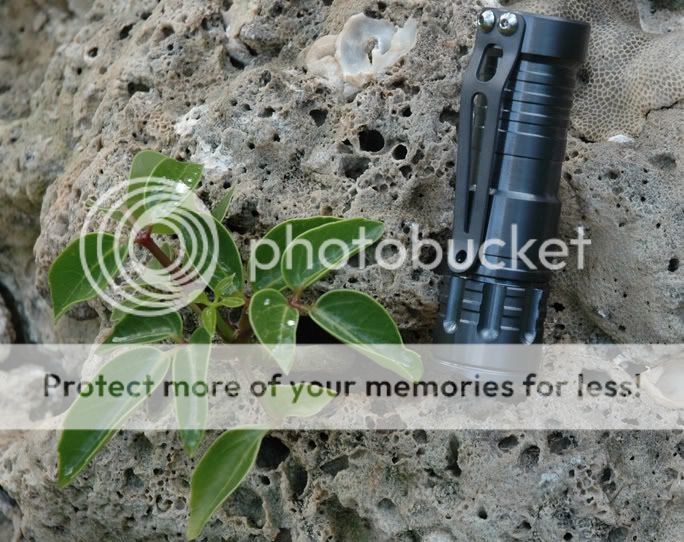
This coating is said to be *very* tough. Only very few pieces are made like that.
Tool marks, cosmetics and Imperfections
The words of Mr. McGizmo himself:
"These lights are about form and function and not beauty. I appologize for where they fall short on form and function but not on their lack of perfection at the surface. I promise that they are imperfect at the surface!
I would hope that any of you who decide to spend a good chunk of your hard earned money on one of these lights receives it and finds it exceeds your expectations. The only way I can hope for this to come about is to convince you, prior to purchase, that these are a marginal, POS. They actually are better than this but it's such a subjective call beyond actual function. The Cree XR-E is state of the art in terms of lux and flux but is not a white wall winner on many fronts.
In so many threads, I read "For a price like that, one would expect....."
With high expectations, these lights will let you down. With low expectations they might please you. In either case they WILL bring light to that which was in shadow or we do have a problem that is mine and one I need to take care of imediately!
...
These lights with their Ti hosts and sapphire windows and drive levels below max spec are not about maximum efficiency or illumination. They are about viable and dependable light in less than hospitable or ideal conditions and environments."
Thanx for reading.
McGizmo Marketing Department
FAQ: McLuxIII Ti Series
______________________________
Note:
All those interested in the newest iteration of the McLuxIII-Ti-Series, the LunaSol lights, should go here:
https://www.candlepowerforums.com/posts/2407045#post2407045
This is the FAQ for the McLuxIII Titanium Series of lights by McGizmo.
As those lights originate from the McLuxIII-PD and develop that concept further, please refer to the McLuxIII-PD FAQ for the basics while this FAQ will expand on the new characteristics specific to the new titanium lights.
Because of the rapidly changing landscape of LED those lights were initially called "mCree" lights for their use of the Cree XR-E LED, but that concept had to be abandoned due to new LEDs arriving. They are now integrated in the new McGizmo nomenclature with the current name.
In this FAQ only the new XR19 and XR27 / S27 lights with either C-Pack or PD-Pack are discussed as the other titanium lights (McLuxIII-Ti-PD and McLuxIII-T) are already covered in the McLuxIII-PD FAQ.
What are the McLuxIII-Ti lights?
The lights are those:

There are two types of heads ... the XR19 and the XR27 ... and two types of bodies ... the C-pack and the PD-pack. Combinations of those form the different lights pictured above. The referenced light on the left hand side is the McLuxIII-ti-PD, the titanium version of the McLuxIII-PD.
Here is a size comparison between the XR19-C, the McLuxIII-ti-PD and the McLuxIII-T:

What about Lego then?
Heads and bodies of the new lights are interchangeable. You thus need to buy two lights to have all parts at hand to be able to build all iterations by simply swapping heads / bodies.
The McLuxIII-ti-PD is compatible, too, but the McLuxIII-T is not, only the head of the "T" will work on both new packs.
This is an example of the XR19 head on the body of the McLuxIII-ti-PD forming a XR19-PD:

Construction
The McLuxIII-Ti lights are made of titanium in and out except the heatsink inside the head which is aluminium. The window is a 2mm optically coated (inside) Sapphire Crystal. The clip is bead blasted titanium held in place with titanium screws. As the C-pack is longer it sports a new and longer clip with a similar form factor, function and quality.
At the business end of the XR19 head there's now not a simple o-ring but a glow-ring:

Both lights use well-known reflectors from the McR-XX Line that have been adapted to use the Cree LED. It is the McR-19XR and the McR-27XR, thus the name of the lights and heads. Due to the additional height necessary to properly focus this LED the heads are longer than the standard McLuxIII-PD head.
The reflector in the XR19 head has an O-ring around it which helps centering it as well as retaining it in position in the head.

These lights will all be host to a Cree XR-E LED mounted on a MCPCB. The bin of the LED is P4 or better.
While the XR19 head has a traditional front end with the well-known titanium bezel ring, the XR27 head uses a system with two o-rings to hold the window in place similar to the HD45 lights. You will notice that the XR19 head now has 8 grooves for better grip as opposed to the 6 grooves of the McLuxIII-ti-PD.
The converters and heat sinks are held in place by a screw in a similar but not identical way as with the McLuxIII-ti-PD. For further details about the building process of those please refer to this thread:
http://candlepowerforums.com/vb/showthread.php?t=142830



The PD-pack will be very similar to the kown PD bodies and will most likely sport a H3-vial in the tail end of the piston.
The C-pack however, incorporates a new rear-end seal. It is also thinner than the PD-pack because of the missing piston.

It uses a user-accessible and -replaceable McClicky switch module for single stage clicky-action with momentary on. No reverse clicky.
The switch boot is held in place with two o-rings and is not screwed in with a metal ring. The reasons for this are:
- this method serves as a pressure relief in case of a battery problem
- it is easily user accessible and easy to clean
- it is watertight, at least in the testing done so far in the ocean*)
For further details refer to the above-linked thread.
These parts are all in contact and some compression with eachother with the result that it takes some additional force to push the button in for momentary and an obvious additional effort to push the button in far enough to latch the light on. The force is not excessive by any means but it is not a simple feather touch either.
You can stick your finger into the side of the button, inside of the guard and pop up the boot and retaining O-ring for removal. It is highly unlikely that an encounter would accidentally pop the boot out ... but still a remote possibility. If one is concerned about this, one could use some type of rubber sealant or glue to bond the components in place and understanding that they would have to overcome those bonds should they want to disassemble the pak.
One thing that might or might not occur (depending on the individual light and parts) is that the rubber boot of the C-pack could extend past the rim of the pack and cause the light to wobble when in tailstand, especially when the light is hot from long burns and the internal pressure builds up. See this thread for more details:
https://www.candlepowerforums.com/posts/1756134#post1756134
*) McGizmo's testing facilities have the following to report: "I water tested the first article a number of times (successful) and today, in the spirit of R&D after reading your question, I took one of the production heads and clickie paks to the beach for a swim. I took it down to about 25' and clickied ita few times on the way down as well as up. Repeated a couple times. There was no water entry. I left all the guts out so I could peer into the window to see where the water might enter if it did. The design is sound but depends on clean and proper seals. The retaining O-ring is snug against the OD of the boot so I think the seal will be good at warding off dirt and grime that likes to work its way into many seal systems. I am very comfortable claiming the clickie and heads to be water resistant provided seals are as they should be. The design is such that increased pressure will increase the pressure of the seal and not encourage a breach."
More extensive and advanced research was done by Mr_TED_BEAR who "subjected the light to 90psi. Translated that is approximately 6 atmospheres or 180 feet depth equivalent. No leaks."
The Seoul P4 LED in the XR27 head
With the appearance of the Seoul P4 LED that uses the same die as the Cree XR-E (the EZ1000), the XR27 head was changed and now uses the Seoul P4 LED instead of the Cree. Only a few of the XR27 heads with the Cree got made, and this head is now called the S27 Head.

This Seoul P4 LED offers the same brightness and efficiency as the Cree but has a lambertian radiation pattern resulting in a beam that is very similar to the Luxeon beams in the reflectors we know. This means that the S27 head will have a beam pattern similar to lights using the McR-27L, for example the McLuxIII-27LT.
Currently SSC P4 U-bin LEDs will be used. Don measured 94 lumens luminous flux with a such an U-bin equipped S27 head in his IS at 525mA. This might not be an 100% exact number, but it gives us an idea about the flux to expect.
Which Titanium Alloy is used?
To date, the Ti parts provided have all been 6-4. With these new mCree Ti lights, the first run of XR19 heads as well as C paks are all 6-4. The bezel rings on the XR-19 heads are 6-4. The XR27 heads are CP (grade 2). It is likely that the PD paks, pistons and sleeves will be CP at least initially. Beyond this and into the future, Don has asked the machine shop to use either material at their discression and based on price and availability at the time. For all intents and purposes the advantages and disadvantages of the two alloys don't amount to any significance in these lights. 6-4 has an advantage in terms of yield and tensile strength whereas CP has an advantage (by the numbers) in terms of both a lower electrical resistance and lower thermal resistance. Without some sophisticated equipment or sending out for a lab test, none of us would be able to determine which alloy we had in hand.
Titanium is ultra-heavy, right?
Ti-PD (original luxeon version) - 98 grams
Ti XR19-PD -105 grams
Ti XR19-C - 106 grams
Ti XR27-PD - 128 grams
Ti XR27-C - 129 grams
All measurements with SF CR123 on board.
Ergonomics and Using the Light
The lights have two access points to the user interface: rotating the head and doing something at the rear end, depending on the pack you have.
Twisting the head will give you (from OFF position) constant low and upon further rotation constant high mode.
The PD-pack is for momentary activation only. By pressing the piston it gives you from OFF position first momentary low and then momentary high when depressing it deeper. You can of course also have momentary high when in constant low mode via the head which is perhaps the most important feature of this combo.
The C-pack functions just like a normal clicky à la SF Z57 et al.. This means you can pre-dial you desired light level at the head and then use it momentarily or constantly with the clicky. But you do not have momentary high from constant low.
Apart form the obvious differences in the user interface of the two packs ... the C-pack is also longer due to the clicky module and thinner due to the missing piston.
In the end it all comes down to personal preferences and tastes. Chose the interface you would like to use.
Those lights are KISS (keep it super simple) lights that offer 2 regulated levels of light, just like the predecessors of the McLuxIII Series. No complicated modes and menues. No SOS function
Titanium Threads and Twisty Action
This is an issue. The threads are considerably rougher than anodised aluminium threads, and they will require breaking them in. Unfortunately this cannot be done at the huge McGizmo manufacturing plant, so it will be up to the end user.
The threads will get softer, but usually not to the point that they feel like an aluminium PD, for example.
As a consequence, those lights will almost certainly be two-hand twisters, at least untill broken in. Usually you can do it one-handed then, but YMMV.
LED and Electronics
The McLuxIII-Ti lights use the Cree XR-E LED in the XR19 head and the Seoul P4 LED in the S27 head. There is no guarantee on tint, and you should know that while the tint is usually pretty decent and quite uniform it still cannot match the tint perfection found in current Luxeon lights.
In the McLuxIII-Ti Series you get 2 levels of current regulated output.
The GDx2 converter is used in those lights - the same one used on the Ti PD's. Those are designed and built by Wayne (dat2zip, owner of the Sandwich Shoppe). Currently, the low mode is about 25 mA. This has been a reasonable low with the Luxeons and the McR-20, at least that seems to be the majority consensus. With the higher flux of the XR-E and SSC P4 coupled with the XR19 and S27 reflectors, the beam and spill intensities at 25 mA will be noticibly higher than the Luxeon based lights. This will please many and others will wish for an even lower drive level on low. High mode is 525mA as usual.
You can use primary CR123 cells as well as R123 Li-Ion cells in those lights as the GDx2 is a buck/boost converter.
Light output and Beam Shape
First ... the beams from the Cree based lights do not have any hole in very close work. The spot gets brighter and tighter as you bring the distance to target to zero.
Here's a beam study of the XR19 head:

And here are some comparison shots against some other well-known lights, mCree XR19 light always on the right:
vs Ti-PD with UV1J:

vs SF L5:

vs Aleph1 T-bin LuxIII at 1000mA:

(you can see the spill of the Aleph1 when you look carefully)
vs Fenix P1:

(spill of the Fenix is difficult to see)
vs SF A2:

(spill of the A2 is too large and dim to be more of a yellow hue in the pic)
Here's an outdoor shot of a McLuxIII-PD (UYAJ) vs the XR19:

The beam from the XR19 is a generous hotspot and generous corona and a very tight and very bright spill. Due to this fact the low mode makes use of the complete beam admiringly well (as opposed to the Aleph1 for example where the low mode is usually just the spot) ... AND the high beam offers an awesome field of vision with the best "throwing" corona in this size class, making this light tremendously useful in everything but long distances.
However ... the XR19 is not a flood light ... it won't light up everything around you without having to move the light around as the beam is too concentrated for that.
Total luminous flux depends on the bin of the LED used and is considerably higher than current Luxeon lights at the same drive level.
The S27 head has (roughly) the same luminous flux as the XR19, but a different beam pattern offering more throw. This beam is virtually identical with the LuxeonIII in a McR-27L like in the 27LT, for example. The rare XR27 heads do sport a different beam pattern, see below.
Here are some beamshots for beam comparisons, but those are not shots of the actual lights, sorry.
McLuxIII-27LT (LuxIII UX1K at 917mA) vs. Cree version of that light with McR-27XR:

27XR modded McLuxIII-27LT (same light as above) vs. mCree XR19 light:

Here's a white wall study of a S27 head vs a XR19 head done by PSM with different exposures:


And the same two lights outdoors:


And here's an animated gif done by the same man and animated by jch79 of some xCree lights and the Aleph19 from the Shoppe in a ranged shootout:

Runtimes
No "official" runtime tables yet, but as the Vin of the Cree is quite similar to current LuxIII offerings, the runtimes obtained with these lights *should* at least match those of the classic McLuxIII-PD.
Meanwhile ... here's a graph done by jch79 with various batteries and lights:

O-ring Sizes
XR-19 Head:
Window seal - #019 EPDM (or the GID silicone)
Head to pak seal - #017 Silicone (red)
C pak:
Boot Seal O-ring - #016 Silicone (red)
Boot & Seal Retaining O-ring - #113 EPDM
XR27 & S27 Head:
Window Seal O-ring - 2 x 22 mm Buna (Nitrile)
Window retaining O-ring - #025 EPDM
Head to pak Seal - #017 Silicone (red)
27LT & 27LT-S head:
Window Seal - #023 EPDM
2x head to Pak seal - #017 Silicone
PD Piston:
Piston to sleeve seal - #015 Silicone (use #016 for added protection but stiffer activation)
PD head:
Window Seal O-ring - #019 EPDM
Head to sleeve seal O-ring - #017 Silicone
Mule head:
Window seal O-ring - #017
Window retaining O-ring - #018
2-cell Iterations of the Ti-Series Lights
The first 2-cell version coming out is the McLuxIII-S27-Cx2, which means an S27 head (Seoul P4 LED with McR-27S) on a 2xCR123 body with a rear clicky.
The light looks like this:

It sports a Seoul P4 of bin UW0I driven by a DBx2 driver with 917mA on high and 125mA on low level. The mechanical properties and the interfave are the same as with the other lights.
Please note that the titanium host might not be ideal for long burntimes on high, especially when left unattended.
This light will work on 1 x Li-Ion, and depending on the Vin of the LED it might run in regulation. If you have a Li-Ion cell that fits in the body, that is. Please use some caution
 when switching heads from 1x123 to 2x123 bodies !!!
when switching heads from 1x123 to 2x123 bodies !!!Another
 : 2 x R123 might be a problematic combo with the DBx2 driver for unknown reasons. See this thread:
: 2 x R123 might be a problematic combo with the DBx2 driver for unknown reasons. See this thread:https://www.candlepowerforums.com/posts/1964532#post1964532
The Mule
The Mule, or Mule head, is an alternate head for the McLuxIII Series that comes in titanium. It is this one ... mounted on a PD-Pack as sold in the first wave:

The Mule head houses a Cree XR-E LED without secondary optical element (--> without a reflector or optic) behind the usual 2mm thick sapphire window. It is powered by a GDx2 driver with the usual drive currents of 525mA on high and 25mA on low.
This light is a pure flood light that uses the narrow beam angle of the Cree XR-E to achieve its beam shape. It is in no way a light that can reach out and has some throw. If it is throw that you are after ... this light is not for you.
The Bergquist MCPCB with LED seats on a Ti ledge in the head and there is Arctic Silver's Ceramic grease in the mating surface betwen the MCPCB and the Head. The philips screw clamps the MCPCB and the converter PCB in place.
Here's a view down the mouth of the beast:

The original sales thread with some more explanations about the Mule:
https://www.candlepowerforums.com/threads/166918
And here is a beam comparison of the Mule (left) with somw other McGizmo Ti-Series lights ... done by PSM (thanx :bow

The Mizer Option
With the advent of the new and efficient EZ1000 die Don now offers a "Mizer" option with his builds. This means a reduced drive current on high (usually about 300mA instead of 525) for a prolonged runtime and still a brightness gain to what we had before. Runtime on high depends on your battery and LED, of course, but can reach up to roughly 3 hours continious burn. YMMV.
Alternate Finishes and Materials
Almost all those lights are plain titanium, but there are always exceptions and special pieces. One such exception is the AlTiN coated version of the titanium lights, which looks like this:

This coating is said to be *very* tough. Only very few pieces are made like that.
Tool marks, cosmetics and Imperfections
The words of Mr. McGizmo himself:
"These lights are about form and function and not beauty. I appologize for where they fall short on form and function but not on their lack of perfection at the surface. I promise that they are imperfect at the surface!
I would hope that any of you who decide to spend a good chunk of your hard earned money on one of these lights receives it and finds it exceeds your expectations. The only way I can hope for this to come about is to convince you, prior to purchase, that these are a marginal, POS. They actually are better than this but it's such a subjective call beyond actual function. The Cree XR-E is state of the art in terms of lux and flux but is not a white wall winner on many fronts.
In so many threads, I read "For a price like that, one would expect....."
With high expectations, these lights will let you down. With low expectations they might please you. In either case they WILL bring light to that which was in shadow or we do have a problem that is mine and one I need to take care of imediately!
...
These lights with their Ti hosts and sapphire windows and drive levels below max spec are not about maximum efficiency or illumination. They are about viable and dependable light in less than hospitable or ideal conditions and environments."
Thanx for reading.
McGizmo Marketing Department
Last edited:


